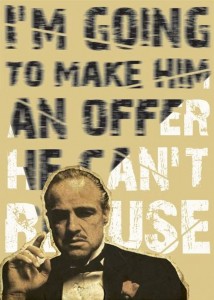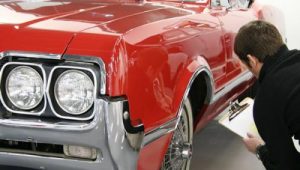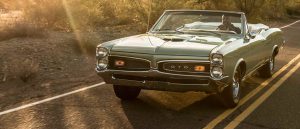There is a form of vehicle insurance that’s not a moral outrage – because you’re not forced to buy it.
Classic car insurance.
Ordinary car insurance (the kind you’re forced to buy) is a bad idea in principle but also when it comes to protecting classic cars because they are considered old cars by the insurance mafia.
And most old cars aren’t worth very much.
Or rather, the mainline insurance companies often don’t think they are – and pay out accordingly.
But your classic might be worth a lot – and not just to you. If it’s been meticulously restored – or in pristine original condition – it’s probably worth more today than whatever it sold for when it was brand-new.
Adjusted for inflation.
Almost always a lot more than whatever the NADA or Kelly Blue Book says it’s worth.
These guides are used car value guides. Using them to value a classic car is like using a generic real estate square foot/how-many-bedrooms-has-it-got calculator to establish the value of a Frank Lloyd Wright House.
If you have ordinary insurance and your classic car is damaged – whether by someone else or by nature, such as a tree branch falling on it at a car show – your “coverage” may not cover very much.
You may have to fight to get the insurer to cover anything.
Classic car insurance, on the other hand, will usually cover everything – guaranteed. Before anything needs to be covered. And it will usually cost your less than the insurance you’re forced to buy – kind of like Obamacare vs. what we used to have when the government didn’t force you to buy “coverage” for that. 
If someone totals your classic car and it’s appropriately covered, at least you’ll get back the full value of the car – which will make you feel a little better about having lost the car.
That’s an offer you shouldn’t refuse.
But why is classic coverage so much better – and so much more reasonable?
Unlike regular insurance, classic car coverage is individualized coverage. Your car isn’t lumped in with other cars and its value assigned according to some one-size-fits-all underwriting formula.
Your policy will be written for for your specific vehicle.
More precisely, its specific condition – which is as much a factor in terms of establishing its value as its make/model/year.
One 2019 Mustang GT is pretty much like any other 2019 Mustang GT. If you suffer a loss, the coverage/payout is based on the average retail market value of a generic 2019 Mustang GT.
Adjusted for depreciation.
But your restored or mint condition/original 1970 Mustang’s value is much greater than the value of a basket-case 1970 Mustang with holes in its floorpans, primer on its panels and blue smoke billowing out of its hanging-by-a-coathanger exhaust pipe.
Any car that has survived 25 years or more – the usual statutory definition of a “classic” car – has become a one-of-a-kind almost by definition. Especially if it’s an original car, with its as-installed drivetrain and factory paint – and in mint condition.
Interestingly, such a car is almost always worth more than a restored car – even if the original car’s paint has a few spider webs or scratches and the engine’s a little greasy.
Because a car is only original once.
But the take-home point as regards insurance coverage is that every classic car is unique.
This is why many classic car policies are based on what’s called agreed value. You and the underwriter come to an agreement as to the replacement value of your particular car – often on the basis of an appraisal and/or documentary substantiation of its condition relative to others like it.
Most policies will take into account such things as original condition, money spent on restoration/modifications – and so on.
The important thing is you and the insurer will come to an agreement about what the car is worth before it becomes necessary to file a claim. Hopefully, it will never be necessary to file a claim. But if it ever does become necessary, you will only have to deal with the trauma of the loss of a beloved possession – not with the loss of your shirt.
There are, of course, some caveats.
Classic car coverage is usually based on limited use – i.e., that the car is not driven daily – and on “classic” (or “antique,” the classification depends on your state) vehicle registration.
The mileage limit is usually adjustable and your rates will vary accordingly. Some insurers will want an odometer reading at policy renewal time. 
Some insurers also require that the covered vehicle be covered – physically, in a garage. You may not be able to get classic vehicle coverage if the vehicle is parked outside or even under a carport.
The usual rule is an enclosed/secure garage.
The reasons for both caveats are obvious and reasonable – and account for the usually lower cost of classic car coverage – even though the potential payout in the event of a loss is much higher than it would be under the terms of even a “full coverage” standard insurance policy. Because the payout isn’t based on the rapidly depreciating generic book value of a new-ish car.
No ordinary policy will pay what you paid for your new car – unless you’re lucky enough (so to speak) to wreck it within a month or so of having driven it off the dealer’s lot. If it’s a year after you drove it off the lot, you’ll be lucky to get 85 percent of what you paid for it.
Less, the next year.
Because new cars lose value with each passing year – and mile. Classic cars usually at least hold theirs . Often, their value goes up.
But only if they are well-kept, kept under cover – and not driven as much.
Hence the policy caveats. But well worth it, for once.
…
Got a question about cars – or anything else? Click on the “ask Eric” link and send ’em in!
If you like what you’ve found here please consider supporting EPautos.
We depend on you to keep the wheels turning!
Our donate button is here.
If you prefer not to use PayPal, our mailing address is:
EPautos
721 Hummingbird Lane SE
Copper Hill, VA 24079
PS: Get an EPautos magnet (pictured below) in return for a $20 or more one-time donation or a $10 or more monthly recurring donation. (Please be sure to tell us you want a sticker – and also, provide an address, so we know where to mail the thing!)
My latest eBook is also available for your favorite price – free! Click here. 












Sometimes coming up with a value is tough. Petrol Lounge, a collector car storage facility in Austin, had a BMW 335 Cabriolet there for a year. It was one of four known to exist, and a Pebble Beach winner.
https://4.bp.blogspot.com/-BtD_Um6QIZA/WALpB3ulTiI/AAAAAAAABow/NafmKPMg2WQ8KDDGPqKiqZO1F7thhPragCEw/s1600/BMW%2B100-36.jpg
Per the insurance policy, they couldn’t publicize the fact that it was there, or acknowledge that it even existed. Doing so would have raised the risk of a theft to unacceptable levels.
I wish it were the case that once a vehicle does qualify for ‘classic’ (25+ years or whatever) that you weren’t forced to buy any insurance! It sounds great to say you’re not forced to get classic insurance, but aren’t they still gonna come for you on the regular? Sigh…
A while back it looked like I was getting a pretty substantial windfall, and I wanted my “gold watch” to be a classic car. When I was checking out insurance I decided to see if I could lump my other vehicles in with the policy. ’92 Mustang was no problem, of course, but I was surprised to discover they’d also include my ’03 VTX 1300 motorcycle, both for one heckuva lot less than I’m paying now, at full (or greater than) pay-off value! Only my work van was a no-go for coverage, though one rep with whom I spoke suggested I might be able to claim it as a tow vehicle and insure it along with a trailer to transport a classic. All for considerably less than Flo picks from my pocket twice a year.
Excellent, Bill!
I pay less to fully (agreed value) cover my classic muscle car than I do for a basic/liability-only policy – which I’m forced to buy – on my ’02 Nissan pick-up.
Are there any recommendations on classic insurance companies to go with?
Hi Anthony,
Hagerty and American Collectors are two I have personally dealt with – and can recommend.
So all I need to do is acquire enough classic cars to be able to use the fleet of them as my daily drivers (mileage spread out over the fleet) and then I won’t have to deal with any of those big brother newer cars ever again. 🙂 GOALS!
Nice post Eric.
I wish there were a “semi-classic” category, that could include all the cars built during those Golden Years, circa 1999 to 2008. Like your 2003 Nissan/Datsun. They will be classics eventually. But not yet. Until then, it’s hard to cover them for what they actually are worth.
Yeah, I had the same thought. Even a 1999 doesn’t hit the 25 year threshold. 99 to 08 really is a sweet spot of just the right amount of independence for the driver and just the right amount of useful tech. While you can’t insure them for what they are worth yet, you can buy them cheaply for a few more years until the general populace wakes up and begins to realize how shitty “assist tech” and touch screens really are.
I disagree. As far as I’m concerned, 94 was the last year to not have an electronic nightmare. My 93 Turbo Diesel was mechanically injected and had NO computer of any sort. It had power everything, with Captain’s chairs, a/c, tilt steering wheel and even a real oil, voltmeter and speedo. I’d rather not have a mechanical tach and it didn’t. I have to wonder what else you’d want on one.
No usb port, oh my god, how did I survive that? No built in inverter but it had an add-on 400 watt inverter that would power electric tools. Unlike that Dodge I drove, the e-brake would lock the rear wheels. If you need more electrical outlets, a strip is really cheap and easy to install where ever you want. The seats were way above what you get now. I see 2 year old pickups now that have been used hard and the seats are worn out.
The front hubs were a simple inner and outer bearing with seals and could be serviced easily. Now you have to buy new hubs since they have a single “dry” bearing, not worth a shit for living where I do. Oh, the indignity of having a transfer case lever instead of a button. When I can’t get that old one into another mode, I know it’s toast. When you can’t get a newer one with pushbuttons into another mode, it’s anybody’s guess what the problem might be. There’s a great deal to be said for simplicity.
Agree with you 8. In 96 you could no longer avoid airbags- now a 23 year old explosive device in front of your face. Carbs finally went out around 88, so the sweet spot for a daily is in the 88-95 range, or for me something older with EFI, overdrive, and roller cam swapped in.
Ernie, I don’t even want the roller cams unless they can match the old flat tappet jobs that got such good mileage. I have no intention of racing. If I want to do that, I’ll build something that you can believe will be a racer. Otherwise, I like the old 350 TBI’s that got over 20 mpg. I personally know 3 of those old pickups that had over a half million miles and were still running fine. What you might have to replace is the distributor…..bfd.
Hi Eight!
I have been thinking about this business of roller vs. flat tappet. I can get a much more aggressive and streetable profile with a roller. I checked out some of the cam specs available for my TA’s 455 and the gist is that I can go from what I have – which is basically the RA III grind – to a RA IV (in roller form) and gain about 30 hp without the idle getting too choppy.
I am very tempted…
eric, it’s not so much the grind of the cam as the reliability and the durability. I haven’t seen the new roller cam engines go half a million miles. If you can keep a close ear, you can probably hear when they’re beginning to go. They begin to make a tiny noise.
I rented a new Ram last week with a hemi. When I started it, I could hear a lot of tiny noise top end. I already knew they were having hemi’s lay down because the roller bearings in the lifters are dying. Of course, you or I could avoid this to some extent since Dodge isn’t known for quality control on their parts.
I’ve had Dodge’s leak on the water neck where the hose connects on the outside of the thermostat. The castings were so sorry that in places the bubbles in the casting were only a few thousands of an inch thick.
Things like this were one reason I always like GM. I know they dropped the ball on some things, like the first aluminum PowerGlides(reaching back)but they got sorted out fairly quickly.
I’m not aware of diesels in big rigs that use roller lifters or roller rockers. I am aware of a lot of diesels that went beyond 1.5 M miles with almost no problems. Oh, you might have to eventually replace the injector cup and that’s on every brand. It’s up there and taking the brunt of every stroke, esp. the power stroke.
Some dislike the ISX Cummins but I’ve seen them go a helluva long ways with virtually no wear…and still have that injector cup problem.
An engine that’s just been dropped, the Detroit 60 series, is renowned for its longevity. I suspect the new DD series is going to do the same from what I’ve seen.
While Cat makes some good engines, especially the engines used in a constant rpm mode such as pump and power units, their truck engines have more than their fair amount of problems, even shedding weights on the timing gears.
But really, I don’t recall any really long life engines with roller cams. I suspect there is a limit on all roller bearings in an engine that’s sooner than flat tappet problems.
As far as replacing the cam on your TA, I’d be all over that. I don’t think you intend to put hundreds of thousands of miles on it….and that’s the very reason they’re so common these days. How many people expect an engine to go half a million miles? Rarely would anyone drive one that long even if it would go that far. Everyone seems to need the “new” style. I don’t see anything these days that would “keep” my eye.
Morning, Eight!
Yep- that’s my reasoning here as well. The TA sees maybe 500 miles annually – so it’ll take a while to wear out the new cam! I think I have about 7,000 miles on the 455 since the last rebuild. The bottom end should be good. What I have in mind is an earlier set of heads (factory iron) with smaller chambers and higher CR, to bump me from the current 7.6:1 (yes, really) to around 9-ish. I think I can get away with this on today’s readily available high octane premium. That plus the more aggressive RA IV grind ought to give me the pinch in the cheeks I am looking for!
Carbs were phased out-especially by Ford. They built MPI and carb trucks on the same lines for at least 4 years. GM did it for at least 3.
Last non-computerized engine I can think of is the early-98 12v Cummins.
Eric,
What year was this type of insurance outlawed?
Hi T,
Classic insurance has never been outlawed; it has always been optional. Unlike regular insurance – which you’re forced to buy.
Eric,
That seems almost free market.
Not sure if I should be happy or afraid.
What’s the deal on getting a policy that covers me driving someone else’s car?
I used to have such a policy, but no insurance company I’ve contacted this century offers it.
eric, beginning 15 years ago no insurance company would sell me comprehensive on my 93 which looked new. At the time, it wasn’t a “classic” if 25 years is the sweet spot.